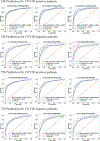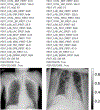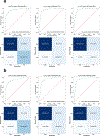Federated learning for predicting clinical outcomes in patients with COVID-19
- PMID: 34526699
- PMCID: PMC9157510
- DOI: 10.1038/s41591-021-01506-3
Federated learning for predicting clinical outcomes in patients with COVID-19
Abstract
Federated learning (FL) is a method used for training artificial intelligence models with data from multiple sources while maintaining data anonymity, thus removing many barriers to data sharing. Here we used data from 20 institutes across the globe to train a FL model, called EXAM (electronic medical record (EMR) chest X-ray AI model), that predicts the future oxygen requirements of symptomatic patients with COVID-19 using inputs of vital signs, laboratory data and chest X-rays. EXAM achieved an average area under the curve (AUC) >0.92 for predicting outcomes at 24 and 72 h from the time of initial presentation to the emergency room, and it provided 16% improvement in average AUC measured across all participating sites and an average increase in generalizability of 38% when compared with models trained at a single site using that site's data. For prediction of mechanical ventilation treatment or death at 24 h at the largest independent test site, EXAM achieved a sensitivity of 0.950 and specificity of 0.882. In this study, FL facilitated rapid data science collaboration without data exchange and generated a model that generalized across heterogeneous, unharmonized datasets for prediction of clinical outcomes in patients with COVID-19, setting the stage for the broader use of FL in healthcare.
© 2021. The Author(s), under exclusive licence to Springer Nature America, Inc.
Conflict of interest statement
Competing interests
Financial competing interests
This study was organized and coordinated by NVIDIA. Y.W., M.A., I.Y., A.Q., C.C., D.B., A.F., H.R., J.G., D.X., N.R., A.H., K.K., C.R., A.A., C.K.L, E.H., A.L., G.L., P.M.C.S, J.T., and M.G.F. are employees of NVIDIA and own stock as part of the standard compensation package.
J.G. declared ownership of NVIDIA Stock.
I.D. is presently an officer and shareholder of a company, Rhino HealthTech Inc., that provides systems for distributed computation, that can among other things, be used to complete federated learning tasks. He was not employed by this company during the execution of the EXAM study.
The remaining authors declare no competing interests.
Non-financial competing interests
C.H. declared Research travel, Siemens Healthineers AG; Conference Travel, EUROKONGRESS; GmBH; and Personal fees (Consultant, GE Healthcare LLC; DSMB Member, Focused Ultrasound Foundation).
F.J.G declared research collaborations with Merantix, Screen-Point, Lunit and Volpara, GE Healthcare and undertakes paid consultancy for Kheiron and Alphabet.
M.L. declared that he is the co-founder of PediaMetrix Inc. and is on the Board of the SIPAIM Foundation
S.E.H declared research collaborations with Merantix, Screen-Point, Lunit and Volpara.
B.J.W and S.X. declared that NIH and NVIDIA have a Cooperative Research and Development Agreement. This work was supported (+/− in part) by the NIH Center for Interventional Oncology and the Intramural Research Program of the National Institutes of Health, via intramural NIH Grants Z1A CL040015, 1ZIDBC011242. Work supported by the NIH Intramural Targeted Anti-COVID-19 (ITAC) Program, funded by the National Institute of Allergy and Infectious Diseases. NIH may have intellectual property in the field.
The remaining authors declare no competing interests.
Figures














Update of
-
Federated Learning used for predicting outcomes in SARS-COV-2 patients.Res Sq [Preprint]. 2021 Jan 8:rs.3.rs-126892. doi: 10.21203/rs.3.rs-126892/v1. Res Sq. 2021. Update in: Nat Med. 2021 Oct;27(10):1735-1743. doi: 10.1038/s41591-021-01506-3. PMID: 33442676 Free PMC article. Updated. Preprint.
References
-
- Budd J et al. Digital technologies in the public-health response to COVID-19. Nat. Med 26, 1183–1192 (2020). - PubMed
-
- Chen Q, Allot A & Lu Z Keep up with the latest coronavirus research. Nature 579, 193 (2020). - PubMed
-
- Fabbri F, Bhatia A, Mayer A, Schlotter B & Kaiser J BCG IT Spend Pulse: How COVID-19 Is Shifting Tech Priorities (2020).
-
- Candelon F, Reichert T, Duranton S, di Carlo RC & De Bondt M The Rise of the AI-Powered Company in the Postcrisis World (2020).
Publication types
MeSH terms
Grants and funding
LinkOut - more resources
Full Text Sources
Other Literature Sources
Medical

